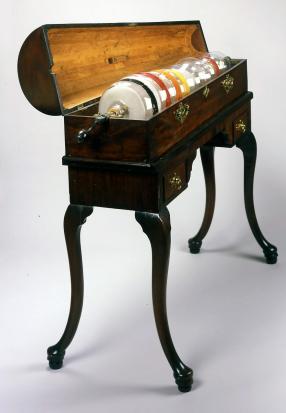Glass armonica, 1761-1762
|
|
The armonica's case or box has a convex mahogany lid that tapers from 11 inches at its wide end to 6 1/4 inches in diameter at its narrow end. The domical curved surface of the lid is veneer that is laid over a deal interior, consructed like a barrel (of tapering staves that abut each other). The edges of the curved lid are finished with a row of cockbeading. It is fastened along one edge of its length, using three brass hinges, to a deep trapezoidal wooden box that contains the moving parts of the instrument. The box containing the glass discs is finished in careful detail, with nosing at all corner joints, veneer capping the upper edges and moulding along the lower edges. A large brass bail handle is positioned at the center of the lid, to permit it to be lifted. The instrument is fitted into a freestanding base, 28 inches high, sliding in at the wide end. The base is configured like a dressing table, with a 6-inch-high skirt broken at the center of one long side to permit a player to sit at the armonica. A pair of shallow drawer fronts flank the player's opening in the skirt, each with cockbeaded edges and a single brass pull. The front on the viewer's right is a true drawer; that on the left is a facade, placed to provide visual balance. The stand is supported on four splayed cabriole legs with rounded pad feet on small balls. The parts of the armonica that constitute the playing instrument are a "hard iron" (steel) rod positioned at a semi-circular cut in the upper edge of the wide end of the box, and held in place by a brass stay that is mounted on a thick wooden plinth glued to the side wall of the box. It tapers from about 1-inch diameter at the thick end to about 1/4-inch at the opposite side wall of the box. On it are mounted a series of 18 shallow glass bowls of decreasing size, held in position on the rod or spindle by corks fixed through holes drilled in their centers. The bowls with rims painted with a series of colors (to denote differing tones) are original. The others are replacements. An elbowed iron crank with an egg-shaped knob extends from a square-in-section iron end of the steel rod. Missing is the means by which the bowls were originally turned: a foot treadle or wheel to rotate the axle. In its present configuration, the instrument requires the assistance of a person turning the crank; as originally built, it could be played by a single person, pumping the treadle to keep the flywheel turning.
|
|






